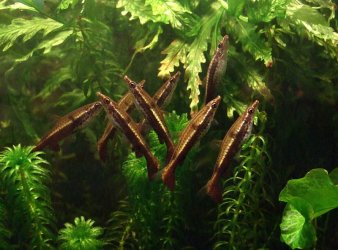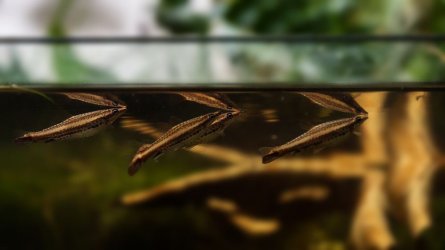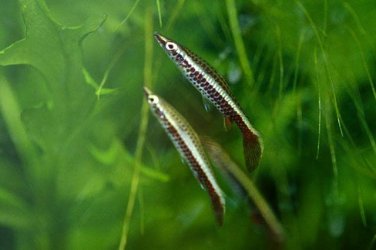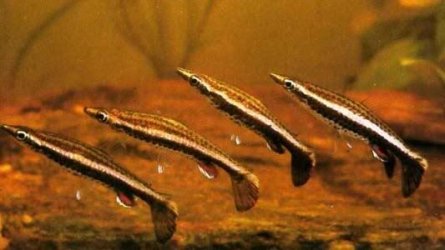I bought some fish today and found this pencilfish had snuck into the bag. I doubt I can provide for it (I guess it needs friends) but can anyone tell me it’s requirememts. Sorry for the photo, it is really small.

You are using an out of date browser. It may not display this or other websites correctly.
You should upgrade or use an alternative browser.
You should upgrade or use an alternative browser.
Stowaway pencilfish
- Thread starter Naughts
- Start date
The April FOTM Contest Poll is open!

🏆 Click to vote! 🏆
I think this is Nannostomus eques; it will swim at an oblique angle to the surface, and the mouth is terminal. The lower lobe of the caudal fin appears to be dark brown (extended from the lower body stripe) which is why I suggest this species. All pencilfish (except N. espei) have an horizontal solid stripe pattern of some sort. I will post some photos of this species and you can compare with your fish. And yes, it absolutely must have a group, this is a very timid and sensitive fish. I have had a group of them for probably 30 years now (not the same fish, lol) and they frequently spawn. But they are very timid. Here's my profile on the species which appears online elsewhere:
Nannostomus eques
Family: Lebiasinidae, Subfamily Pyrrhulininae
Common Names: Rocket Pencilfish, Diptail Pencilfish
Origin and Habitat: Rio Negro, Brazilian Amazon basin; Western Columbia; Guyana. Inhabits sluggish streams, swampy areas and flooded forest, occurring around branches and/or vegetation.
Compatibility/Temperament: Peaceful shoaling fish, must be kept in a group of at least six but preferably more. Males will challenge each other, but without damage. Should not be kept with lively nor aggressive fish.
Diet
Accepts prepared foods from the surface that are small enough to fit the mouth. Carnivorous, in nature they feed on tiny insects at or near the surface, and small creatures on plants and underwater branches. Live food such as wingless fruit flies are a treat.
Size: Grows to 2 inches.
Minimum Tank Suggestion 18-24 inches
Water parameters Soft (less than 4 dGH), slightly acid (pH below 7.0), temperature 23-28C/73-82F. For spawning, the water must be softer (around 2 dGH) and pH 6.0 or lower.
Discussion
This interesting little fish is now frequently seen under the common name of Rocket Pencilfish, and sometimes Hockeystick Pencilfish.
A quiet, sedate fish well suited to a heavily-planted aquarium of gentle fishes; when housed with active fish, this species may be too frightened to eat. Floating plants (essential) will increase the fish's sense of security and also decrease the light which is very beneficial. It spends the day among plants and branches, searching for food; the mouth is forward (terminal) and always open, and designed such that the fish can easily pick up minuscule prey from plants and branches. This species swims in a head-up position, and remains in the upper half of the aquariium among plants and branches.
Nannostomus eques possesses an adipose fin, though it may be absent on some individuals. In common with all pencilfish, except for N. espei, this fish has a diurnal colour pattern. During darkness, the horizontal lines break up into a series of dashes. This has been observed in blind fish, showing that it is an automatic response to light/dark and not controlled by the fish.
Males are more slender than females, and the colouration of the fins is brighter. Will readily spawn but only in very soft, acidic water. The pair select a leaf and the eggs are deposited on the underside.
All pencilfish are found in the tribe Nannostomini in the subfamily Pyrrhulininae. Three different genera (Nannostomus, Nannobrycon and Poecilobrycon) were used at various times prior to Weitzman & Weitzman (2003). The subject fish was originally described as Nannostomus eques by F. Steindachner in 1876, using specimens from the Peruvian Amazon; the genus had been erected in 1872 by Gunther with N. beckfordi as the type species. In 1910, C.H. Eigenmann assigned the present species to the genus Poecilobrycon which he had erected that year for the type species P. harrisoni [now Nannostomus harrisoni]. In 1950, Hoedeman proposed placing P. eques in his newly-erected genus Nannobrycon; the basis he used was the oblique swimming position and a peculiarity of the caudal fin, both traits unique to only this species and N. unifasciatus [Hoedeman considered N. unifasciatus to be a synonym for the subject species]. He also alluded to a different shape of the swim bladder; Weitzman (1966) suggested that extensive anatomical study of all species in the tribe would clarify this point, but he opinioned that the oblique swimming position does suggest this.
In spite of the fore-going, Weitzman (1966) decided to place this species in Nannostomus, noting that future study might justify the two species N. eques and N. unifasciatus being moved to their own genus. Gery (1977) actually did this, but added no new evidence beyond what Hoedeman and Weitzman had mentioned. Weitzman & Weitzman (2003) listed all known species, including these two, in Nannostomus, and to date this has remained the accepted classification.
The name Nannostomus comes from the Greek meaning "small mouth," and Nannobrycon comes from the Greek meaning "small biter;" both names reference the small mouth of the pencilfishes.
References:
Gery, Jacques (1977) Characoids of the World, TFH Books.
Reis, R.E., S.O. Kullander & C.J. Ferraris Jr. (2003), Check list of the freshwater fishes of South and Central America.
Weitzman, Stanley H. (1966), "Review of South American Characid Fishes of Subtribe Nannostomina," Proceedings of the United States National Museum (Smithsonian Institution), Volume 119, Number 3538.
Weitzman, Stanley H. & J.S. Cobb (1975), "A revision of the South American fishes of the genus Nannostomus Gunther (family Lebiasinidae)," Smithsonian Contributions to Zoology No. 186.
Nannostomus eques
Family: Lebiasinidae, Subfamily Pyrrhulininae
Common Names: Rocket Pencilfish, Diptail Pencilfish
Origin and Habitat: Rio Negro, Brazilian Amazon basin; Western Columbia; Guyana. Inhabits sluggish streams, swampy areas and flooded forest, occurring around branches and/or vegetation.
Compatibility/Temperament: Peaceful shoaling fish, must be kept in a group of at least six but preferably more. Males will challenge each other, but without damage. Should not be kept with lively nor aggressive fish.
Diet
Accepts prepared foods from the surface that are small enough to fit the mouth. Carnivorous, in nature they feed on tiny insects at or near the surface, and small creatures on plants and underwater branches. Live food such as wingless fruit flies are a treat.
Size: Grows to 2 inches.
Minimum Tank Suggestion 18-24 inches
Water parameters Soft (less than 4 dGH), slightly acid (pH below 7.0), temperature 23-28C/73-82F. For spawning, the water must be softer (around 2 dGH) and pH 6.0 or lower.
Discussion
This interesting little fish is now frequently seen under the common name of Rocket Pencilfish, and sometimes Hockeystick Pencilfish.
A quiet, sedate fish well suited to a heavily-planted aquarium of gentle fishes; when housed with active fish, this species may be too frightened to eat. Floating plants (essential) will increase the fish's sense of security and also decrease the light which is very beneficial. It spends the day among plants and branches, searching for food; the mouth is forward (terminal) and always open, and designed such that the fish can easily pick up minuscule prey from plants and branches. This species swims in a head-up position, and remains in the upper half of the aquariium among plants and branches.
Nannostomus eques possesses an adipose fin, though it may be absent on some individuals. In common with all pencilfish, except for N. espei, this fish has a diurnal colour pattern. During darkness, the horizontal lines break up into a series of dashes. This has been observed in blind fish, showing that it is an automatic response to light/dark and not controlled by the fish.
Males are more slender than females, and the colouration of the fins is brighter. Will readily spawn but only in very soft, acidic water. The pair select a leaf and the eggs are deposited on the underside.
All pencilfish are found in the tribe Nannostomini in the subfamily Pyrrhulininae. Three different genera (Nannostomus, Nannobrycon and Poecilobrycon) were used at various times prior to Weitzman & Weitzman (2003). The subject fish was originally described as Nannostomus eques by F. Steindachner in 1876, using specimens from the Peruvian Amazon; the genus had been erected in 1872 by Gunther with N. beckfordi as the type species. In 1910, C.H. Eigenmann assigned the present species to the genus Poecilobrycon which he had erected that year for the type species P. harrisoni [now Nannostomus harrisoni]. In 1950, Hoedeman proposed placing P. eques in his newly-erected genus Nannobrycon; the basis he used was the oblique swimming position and a peculiarity of the caudal fin, both traits unique to only this species and N. unifasciatus [Hoedeman considered N. unifasciatus to be a synonym for the subject species]. He also alluded to a different shape of the swim bladder; Weitzman (1966) suggested that extensive anatomical study of all species in the tribe would clarify this point, but he opinioned that the oblique swimming position does suggest this.
In spite of the fore-going, Weitzman (1966) decided to place this species in Nannostomus, noting that future study might justify the two species N. eques and N. unifasciatus being moved to their own genus. Gery (1977) actually did this, but added no new evidence beyond what Hoedeman and Weitzman had mentioned. Weitzman & Weitzman (2003) listed all known species, including these two, in Nannostomus, and to date this has remained the accepted classification.
The name Nannostomus comes from the Greek meaning "small mouth," and Nannobrycon comes from the Greek meaning "small biter;" both names reference the small mouth of the pencilfishes.
References:
Gery, Jacques (1977) Characoids of the World, TFH Books.
Reis, R.E., S.O. Kullander & C.J. Ferraris Jr. (2003), Check list of the freshwater fishes of South and Central America.
Weitzman, Stanley H. (1966), "Review of South American Characid Fishes of Subtribe Nannostomina," Proceedings of the United States National Museum (Smithsonian Institution), Volume 119, Number 3538.
Weitzman, Stanley H. & J.S. Cobb (1975), "A revision of the South American fishes of the genus Nannostomus Gunther (family Lebiasinidae)," Smithsonian Contributions to Zoology No. 186.
Don't get a fright if you see it when you turn the room lights on in the morning, it will look like a completely different fishNannostomus eques possesses an adipose fin, though it may be absent on some individuals. In common with all pencilfish, except for N. espei, this fish has a diurnal colour pattern. During darkness, the horizontal lines break up into a series of dashes. This has been observed in blind fish, showing that it is an automatic response to light/dark and not controlled by the fish.
Some friends are definitely a good idea. My pencilfish (different species) stick together more than any of my other fish. Not necessarily one big group but they organise themselves into mini groups of 3-6 fish.
Perfect, thank you for this. It matches your photos although the red is not showing yet. I couldn't identify it because it's caudal fin is indeed dark at the base. I feel sorry for it because I am sure I can't meet it's needs. I put it in my shrimp tank with the lights off but it's only 25 litres. My other tanks have active or semi-aggressive fish. I got it from a shop quite far away. I 'll see if the shop is still open next weekend to take it back or I'll try and catch the manager at my local pet shop who is into fish and might know of a suitable home. Poor little fishy! Thank you for the help.
Thank you SeangeeDon't get a fright if you see it when you turn the room lights on in the morning, it will look like a completely different fish
Some friends are definitely a good idea. My pencilfish (different species) stick together more than any of my other fish. Not necessarily one big group but they organise themselves into mini groups of 3-6 fish.
Latest Discussions
- Replies
- 0
- Views
- 1






